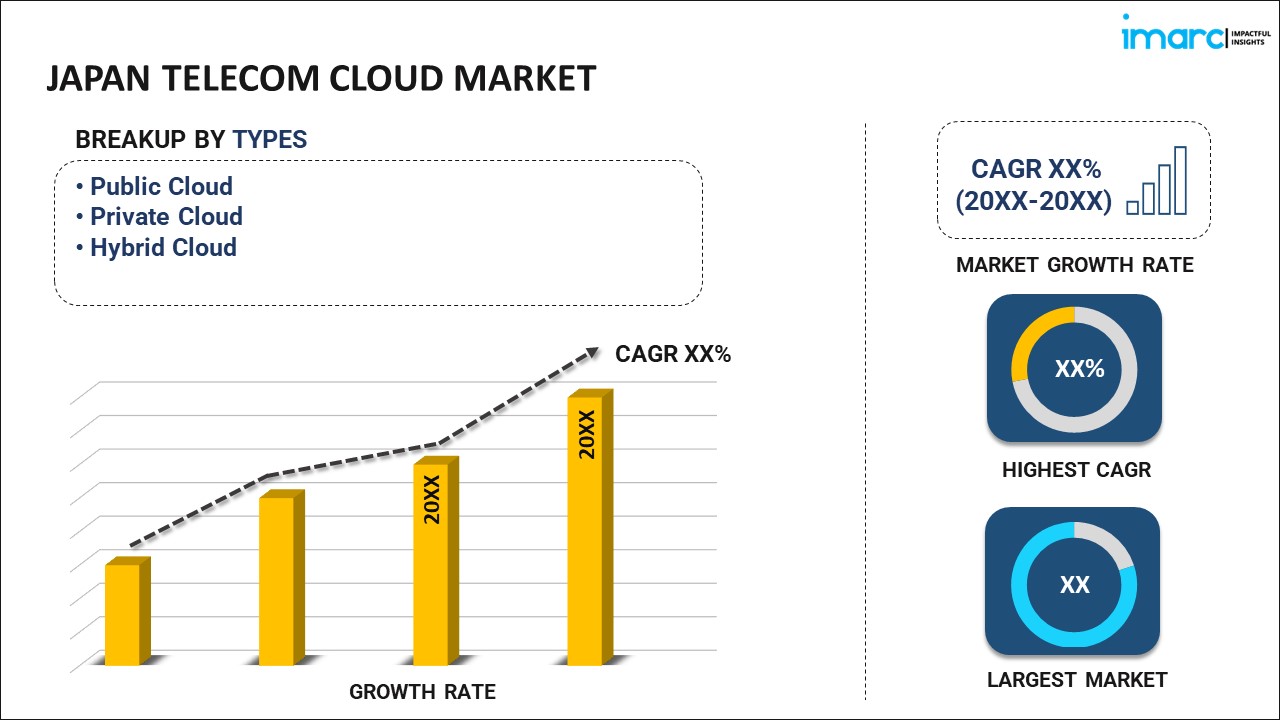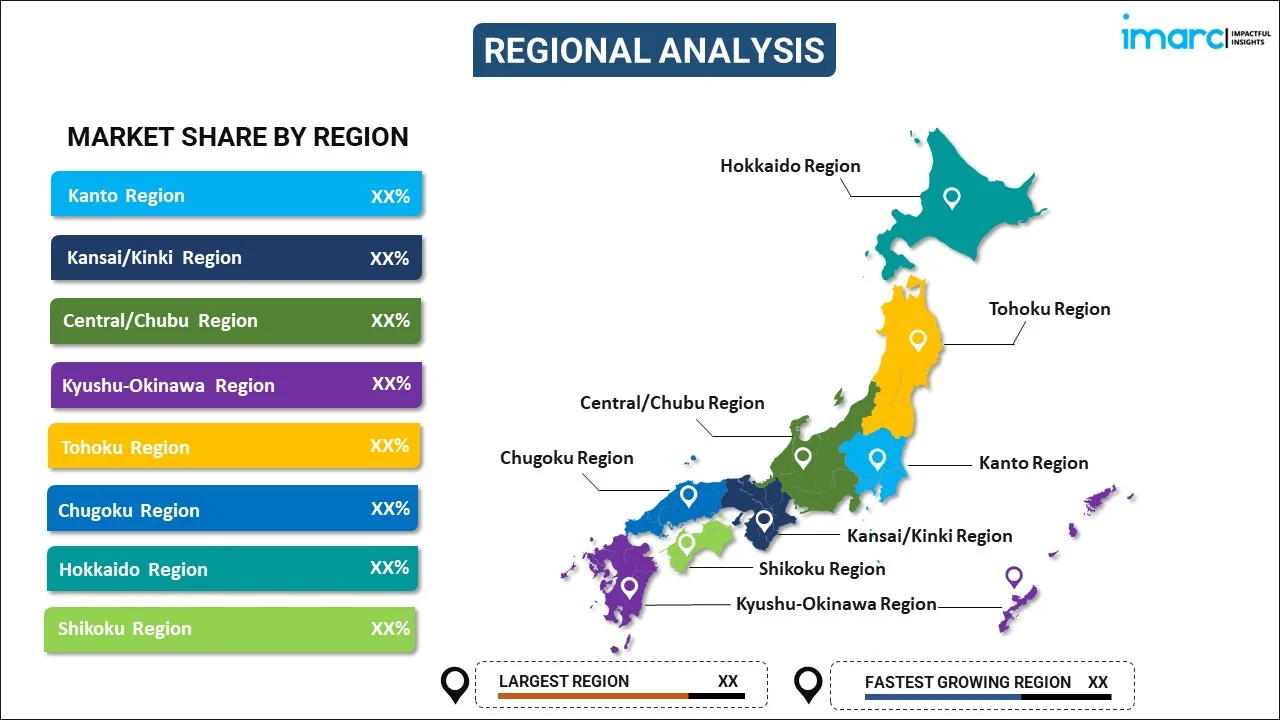
Japan Telecom Cloud Market Report by Type (Public Cloud, Private Cloud, Hybrid Cloud), Computing Services (SaaS, IaaS, PaaS), Application (Computing, Data Storage, Achieving, Enterprise Application, and Others), End User (BFSI, Retail, Manufacturing, Transportation and Distribution, Healthcare, Government, Media and Entertainment, and Others), and Region 2025-2033
Market Overview:
Japan telecom cloud market size reached USD 1.8 Billion in 2024. Looking forward, IMARC Group expects the market to reach USD 10.6 Billion by 2033, exhibiting a growth rate (CAGR) of 19.5% during 2025-2033. The increasing demand for network function virtualization (NFV) and software-defined networking (SDN) technologies to improve network flexibility, scalability, and cost-efficiency, is primarily driving the market.
|
Report Attribute
|
Key Statistics
|
|---|---|
|
Base Year
|
2024
|
|
Forecast Years
|
2025-2033
|
|
Historical Years
|
2019-2024
|
|
Market Size in 2024
|
USD 1.8 Billion |
|
Market Forecast in 2033
|
USD 10.6 Billion |
| Market Growth Rate 2025-2033 | 19.5% |
Telecom cloud, also known as telco cloud, is a transformative technology in the telecommunications industry. It represents the convergence of traditional telecommunications and cloud computing, enabling service providers to deliver a wide range of services, including voice, data, and multimedia, over a virtualized, software-defined infrastructure. This cloud-based approach offers numerous benefits, such as scalability, agility, and cost-efficiency. Telecom operators can dynamically allocate resources, scaling up or down as needed, which enhances network flexibility and responsiveness. Additionally, it enables the rapid deployment of new services and applications, reducing time-to-market. Security and reliability are paramount in telecom cloud environments, as they handle sensitive customer data and mission-critical services. Thus, robust security measures and redundancy mechanisms are integrated to ensure uninterrupted connectivity and data protection. Telecom cloud plays a pivotal role in the deployment of 5G networks, IoT applications, and edge computing, as it provides the foundation for efficiently managing the massive amounts of data generated in the modern digital landscape.
Japan Telecom Cloud Market Trends:
The telecom cloud market in Japan is experiencing robust growth, primarily due to several key drivers that are reshaping the industry landscape. Firstly, the increasing demand for scalable and flexible network infrastructure is pushing telecom operators to embrace cloud solutions. Consequently, cloud technology enables them to efficiently manage network resources, optimize bandwidth allocation, and enhance overall service delivery. Additionally, the surge in data consumption and the proliferation of connected devices, often referred to as the Internet of Things (IoT), is a major factor propelling the telecom cloud market forward. With cloud-based platforms, telecom companies can better accommodate the rising data traffic and provide seamless connectivity to a growing number of devices. Furthermore, the need for cost optimization and resource efficiency is compelling telecom operators to migrate to the cloud. By doing so, they can reduce capital expenditure on physical infrastructure, minimize operational costs, and streamline their operations. Moreover, the ongoing transition to 5G networks, with their increased bandwidth and low latency requirements, is creating a strong incentive for telecom operators to leverage cloud solutions for network virtualization and edge computing capabilities. This, in turn, is expected to drive the telecom cloud market in Japan.
Japan Telecom Cloud Market Segmentation:
IMARC Group provides an analysis of the key trends in each segment of the market, along with forecasts at the country level for 2025-2033. Our report has categorized the market based on type, computing services, application, and end user.
Type Insights:

- Public Cloud
- Private Cloud
- Hybrid Cloud
The report has provided a detailed breakup and analysis of the market based on the type. This includes public cloud, private cloud, and hybrid cloud.
Computing Services Insights:
- SaaS
- IaaS
- PaaS
A detailed breakup and analysis of the market based on the computing services have also been provided in the report. This includes SaaS, IaaS, and PaaS.
Application Insights:
- Computing
- Data Storage
- Achieving
- Enterprise Application
- Others
The report has provided a detailed breakup and analysis of the market based on the application. This includes computing, data storage, achieving, enterprise application, and others.
End User Insights:
- BFSI
- Retail
- Manufacturing
- Transportation and Distribution
- Healthcare
- Government
- Media and Entertainment
- Others
A detailed breakup and analysis of the market based on the end user have also been provided in the report. This includes BFSI, retail, manufacturing, transportation and distribution, healthcare, government, media and entertainment, and others.
Regional Insights:

- Kanto Region
- Kansai/Kinki Region
- Central/ Chubu Region
- Kyushu-Okinawa Region
- Tohoku Region
- Chugoku Region
- Hokkaido Region
- Shikoku Region
The report has also provided a comprehensive analysis of all the major regional markets, which include Kanto Region, Kansai/Kinki Region, Central/ Chubu Region, Kyushu-Okinawa Region, Tohoku Region, Chugoku Region, Hokkaido Region, and Shikoku Region.
Competitive Landscape:
The market research report has also provided a comprehensive analysis of the competitive landscape. Competitive analysis such as market structure, key player positioning, top winning strategies, competitive dashboard, and company evaluation quadrant has been covered in the report. Also, detailed profiles of all major companies have been provided.
Japan Telecom Cloud Market Report Coverage:
| Report Features | Details |
|---|---|
| Base Year of the Analysis | 2024 |
| Historical Period | 2019-2024 |
| Forecast Period | 2025-2033 |
| Units | Billion USD |
| Scope of the Report | Exploration of Historical and Forecast Trends, Industry Catalysts and Challenges, Segment-Wise Historical and Predictive Market Assessment:
|
| Types Covered | Public Cloud, Private Cloud, Hybrid Cloud |
| Computing Servicess Covered | SaaS, IaaS, PaaS |
| Applications Covered | Computing, Data Storage, Achieving, Enterprise Application, Others |
| End Users Covered | BFSI, Retail, Manufacturing, Transportation and Distribution, Healthcare, Government, Media and Entertainment, Others |
| Regions Covered | Kanto Region, Kansai/Kinki Region, Central/ Chubu Region, Kyushu-Okinawa Region, Tohoku Region, Chugoku Region, Hokkaido Region, Shikoku Region |
| Customization Scope | 10% Free Customization |
| Post-Sale Analyst Support | 10-12 Weeks |
| Delivery Format | PDF and Excel through Email (We can also provide the editable version of the report in PPT/Word format on special request) |
Key Questions Answered in This Report:
- How has the Japan telecom cloud market performed so far and how will it perform in the coming years?
- What has been the impact of COVID-19 on the Japan telecom cloud market?
- What is the breakup of the Japan telecom cloud market on the basis of type?
- What is the breakup of the Japan telecom cloud market on the basis of computing services?
- What is the breakup of the Japan telecom cloud market on the basis of application?
- What is the breakup of the Japan telecom cloud market on the basis of end user?
- What are the various stages in the value chain of the Japan telecom cloud market?
- What are the key driving factors and challenges in the Japan telecom cloud?
- What is the structure of the Japan telecom cloud market and who are the key players?
- What is the degree of competition in the Japan telecom cloud market?
Key Benefits for Stakeholders:
- IMARC’s industry report offers a comprehensive quantitative analysis of various market segments, historical and current market trends, market forecasts, and dynamics of the Japan telecom cloud market from 2019-2033.
- The research report provides the latest information on the market drivers, challenges, and opportunities in the Japan telecom cloud market.
- Porter's five forces analysis assist stakeholders in assessing the impact of new entrants, competitive rivalry, supplier power, buyer power, and the threat of substitution. It helps stakeholders to analyze the level of competition within the Japan telecom cloud industry and its attractiveness.
- Competitive landscape allows stakeholders to understand their competitive environment and provides an insight into the current positions of key players in the market.
Need more help?
- Speak to our experienced analysts for insights on the current market scenarios.
- Include additional segments and countries to customize the report as per your requirement.
- Gain an unparalleled competitive advantage in your domain by understanding how to utilize the report and positively impacting your operations and revenue.
- For further assistance, please connect with our analysts.
 Inquire Before Buying
Inquire Before Buying
 Speak to an Analyst
Speak to an Analyst
 Request Brochure
Request Brochure
 Request Customization
Request Customization




.webp)




.webp)












